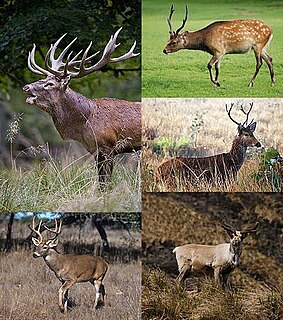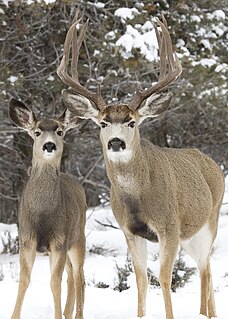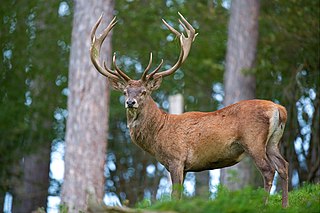
Deer are the hoofed ruminant mammals forming the family Cervidae. The two main groups are the Cervinae, including the muntjac, the elk (wapiti), the fallow deer, and the chital; and the Capreolinae, including the reindeer (caribou), the roe deer, and the moose. Female reindeer, and male deer of all species except the Chinese water deer, grow and shed new antlers each year. In this they differ from permanently horned antelope, which are part of a different family (Bovidae) within the same order of even-toed ungulates (Artiodactyla).

The Père David's deer, also known as the milu or elaphure, is a species of deer that went extinct in the wild, but has been reintroduced in some areas. The milu is native to the river valleys of China, where it prefers wetland habitats. It grazes mainly on grass and aquatic plants. It is the only extant member of the genus Elaphurus. Based on genetic comparisons, Père David's deer is closely related to the deer of the genus Cervus, leading many experts to suggest merging Elaphurus into Cervus, or demoting Elaphurus to a subgenus of Cervus.

Chevrotains, also known as mouse-deer, are small ungulates that make up the family Tragulidae, the only members of the infraorder Tragulina. The 10 extant species are placed in three genera, but several species also are known only from fossils. The extant species are found in forests in South and Southeast Asia, with a single species in the rainforests of Central and West Africa. They are solitary or live in pairs, and feed almost exclusively on plant material. Chevrotains are the smallest hoofed mammals in the world. The Asian species weigh between 0.7 and 8.0 kg, while the African chevrotain is considerably larger at 7–16 kg (15–35 lb).

The white-tailed deer, also known as the whitetail or Virginia deer, is a medium-sized deer native to the United States, Canada, Mexico, Central America, and South America as far south as Peru and Bolivia. It has also been introduced to New Zealand, Cuba, Jamaica, Hispaniola, Puerto Rico, the Bahamas, the Lesser Antilles, and some countries in Europe, such as Finland, the Czech Republic, Romania and Serbia. In the Americas, it is the most widely distributed wild ungulate.

The mule deer is a deer indigenous to western North America; it is named for its ears, which are large like those of the mule. The several subspecies include the black-tailed deer.

The red deer is one of the largest deer species. The red deer inhabits most of Europe, the Caucasus Mountains region, Asia Minor, Iran, parts of western Asia, and central Asia. It also inhabits the Atlas Mountains region between Morocco and Tunisia in northwestern Africa, being the only species of deer to inhabit Africa. Red deer have been introduced to other areas, including Australia, New Zealand, United States, Canada, Peru, Uruguay, Chile and Argentina. In many parts of the world, the meat (venison) from red deer is used as a food source.

Oscar Gomer Swahn was a Swedish shooter who competed at three Olympic games and won six medals, including three gold. Swahn holds records as the oldest Olympian at the time of competition, the oldest person to win gold, and the oldest person to win an Olympic medal.
The ISSF World Shooting Championships are governed by the International Shooting Sport Federation. World Shooting Championships began in 1897, after the successful 1896 Summer Olympics, and although the ISSF was not founded until 1907, these early competitions are still seen by the organization as the beginning of a continuous row of championships. By this logic, the 2006 competition in Zagreb was called the 49th ISSF World Shooting Championships. These championships, including all ISSF shooting events, are held every four years since 1954. For the shotgun events only, there is an additional World Championship competition in odd-numbered years. These extra competitions are not numbered. In running target, there will be World Championships in Olympic years.

Thorold's deer is a threatened species of deer found in grassland, shrubland, and forest at high altitudes in the eastern Tibetan Plateau. It is also known as the white-lipped deer for the white patches around its muzzle.

New Deer is a settlement in Aberdeenshire, North East Scotland that lies in the valley of Deer. It was founded after monks from Deer Abbey, Old Deer built a chapel at Auchreddie, which translates as "field of the bog myrtle". Around 1507 the register of Deer Abbey lists its lands in the "new paroche of Deir". The name Auchreddie has dropped in significance over the years, however the southern end of the village is still known by this name.
The White-bellied musk deer or Himalayan musk deer is a musk deer species occurring in the Himalayas of Nepal, Bhutan, India, Pakistan and China. It is listed as endangered by the IUCN because of overexploitation resulting in a probable serious population decline.
At the 1924 Summer Olympics in Paris, ten events in shooting were contested. These would be the last Games in which team events were part of the Olympic shooting program. The competitions were held from 23 June 1924 to 9 July 1924 at the shooting ranges at Versailles, Reims, Camp de Châlons (Mourmelon), and Issy-les-Moulineaux.

Ole Andreas Lilloe-Olsen was a Norwegian rifle shooter who competed in the early 20th century in rifle shooting. With his five gold medals and one silver medal, he is the Norwegian athlete with the most medals at the Summer Olympics. He participated in shooting at the 1920 Summer Olympics in Antwerp and won the gold medal in 100 m running deer, double shots and team 100 m running deer, single shots and team 100 m running deer, double shots. At the 1924 Summer Olympics in Paris he defended the Olympic titles in 100 m running deer, double shots and team 100 m running deer, single shots and the silver medal in team 100 m running deer, double shots.
Einar Liberg was a Norwegian rifle shooter who competed in the early 20th century. He won the gold medal with the Norwegian free rifle team at the 1908 Summer Olympics in London, and four years later at the 1912 Summer Olympics in Stockholm he won the silver medal with the free rifle team. At the 1920 Summer Olympics in Antwerp he competed in running deer, and won two gold medals in team, running deer, single shot, and team, running deer, double shot. He also took the individual bronze medal in running deer, double shot. In the 1924 Summer Olympics in Paris he ended his long olympic career by taking another gold medal in team, running deer, single shot, and a silver medal in team, running deer, double shot.

Alfred Gomer Swahn was a Swedish sport shooter who competed at the 1908, 1912, 1920 and 1924 Summer Olympics. He won nine medals: three gold, three silver and three bronze. He is the son of Oscar Swahn, an Olympic shooter who competed alongside his son at the 1908, 1912 and 1920 Olympics and won six medals.

100 meter running deer is a discontinued ISSF shooting event, that was part of the Olympic program from 1908 to 1924, in 1952 and 1956, and of the ISSF World Shooting Championships program from 1929 to 1962, when it was replaced by 50 meter running target. Being the original running target event, it was shot with centerfire rifles from a distance of 100 meters, with the target moving sideways across a 20 meter wide opening. There were two versions: single shot and double shot. Occasionally combined competitions, with half the course fired single-shot and half double-shot, were held instead of or in addition to the others. The Nordic Shooting Region continued to hold championships in the discipline until 2004.
Rob Deering, is an English comedian, musician and writer.
The following are the results of the 50 metre running target competition at the 1972 Summer Olympics. Various types of a running target event had been held on and off throughout the history of the Olympics. It was last in the Olympics in 1956 where it was a 100 metre running deer event. This event often consisted as a running deer target at several speeds and distances, but at these games it was contested as a running boar shot at 50 metres at two speeds. The gold medal went to Yakiv Zheleznyak of the Soviet Union. He broke the world record in event with a score of 569. The silver medal went to Helmut Bellingrodt of Colombia this was the first Olympic medal won by a Colombian athlete.
Michael Deering was the fifth president of the Gaelic Athletic Association (1898–1901).

Running target shooting refers to a number of target shooting sports and events involving a shooting target—sometimes called a boar, moose, or deer—that is made to move as if it is a running animal.
















